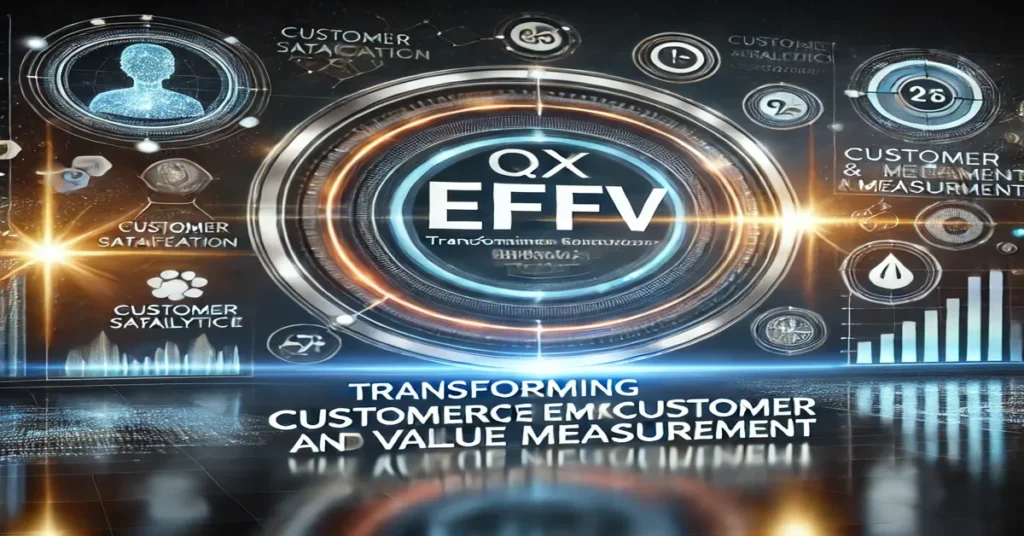In the fast-paced world of business and technology staying ahead requires understanding what truly matters to consumers. Enter Qxefv, an innovative concept that is reshaping how companies measure and enhance customer value. Standing for “Quantitative Measurement of Experiential Value,” Qxefv offers a fresh perspective on customer satisfaction by focusing on two major components: customer experience and measurable value. It’s more than just a metric—it’s a strategy that helps companies refine their products, build loyalty, and gain a competitive edge in their industry.
This article explores the concept of Qxefv, how it works, and why it’s becoming a crucial tool for businesses aiming to thrive in an increasingly customer-centric market.
Understanding Qxefv and Its Core Components
Qxefv serves as a guide for companies to understand how much consumers value their products or services. It involves two core elements that shape this value: Customer Experience and Quantitative Value.
Customer Experience
Customer Experience (CX) is the cornerstone of Qxefv. It encompasses everything from the ease of use, interaction quality, and the effectiveness of a product or service in solving customer issues. Positive customer experiences lead to higher satisfaction and, ultimately, customer loyalty.
Quantitative Value
Quantitative Value represents the measurable benefits a product or service offers, such as increased efficiency, time saved, or cost reductions. It’s the tangible value that customers derive, which can be directly assessed and compared across different offerings.
How Qxefv Works: The Scoring System
Qxefv operates on a scoring system that assigns a quantitative value to how well a product meets consumer needs. A higher Qxefv score indicates that consumers find a particular product or service valuable and fulfilling. The score is derived by combining the experiential value (qualitative feedback) with the quantitative benefits provided.
Businesses that achieve high Qxefv scores have likely succeeded in creating products or services that resonate strongly with their customers. As a result, they enjoy enhanced brand loyalty, customer retention, and a favorable reputation in the market.
Why Qxefv Matters in Today’s Market
In an era where customer expectations are continually evolving, Qxefv offers companies a way to stay connected to their audience’s needs and preferences. Here are some reasons why Qxefv is becoming a game-changer.
Improved Customer Loyalty
A high Qxefv score reflects positive customer experience and value, encouraging customers to return and stay loyal. This is essential for companies looking to build a strong, sustainable customer base.
Enhanced Product Development
By understanding Qxefv scores, businesses can pinpoint which areas of their products need improvement. This data-driven approach allows companies to refine their offerings, ensuring they meet consumer demands effectively.
Competitive Advantage
In competitive markets, having a high Qxefv score can set a company apart from others. Consumers are more likely to choose a product with a proven track record of delivering value and satisfaction.
Calculating Qxefv: Steps to Measure Customer Value
Measuring Qxefv requires a structured approach to gather and interpret data from both qualitative and quantitative sources. Below is a simplified outline of how businesses calculate Qxefv.
Collecting Customer Feedback
Gathering direct feedback is crucial for understanding the experiential aspect of Qxefv. Companies may use surveys, focus groups, or user reviews to collect insights on how consumers feel about the product or service.
Analyzing Quantitative Metrics
Quantitative data involves measurable elements such as time saved, efficiency gains, or cost reductions. This data can be obtained from usage analytics, performance metrics, and other tools that track product effectiveness.
Assigning a Score
By combining insights from customer experience and quantitative data, companies can assign a Qxefv score. This score serves as a benchmark for current performance and highlights areas for improvement.
How Qxefv Impacts Business Success
The impact of a high Qxefv score extends beyond customer satisfaction. Here’s how Qxefv influences various aspects of business success.
Product Pricing Strategies
Products with higher Qxefv scores demonstrate greater perceived value, allowing businesses to justify premium pricing. This increases revenue potential while maintaining a loyal customer base.
Enhanced Customer Insights
Qxef’v provides businesses with a deeper understanding of what their customers value. This insight allows them to refine their strategies, from marketing to customer service, to better cater to consumer needs.
Brand Reputation
Companies known for high Qxef’v scores become associated with quality and customer satisfaction, boosting their brand image. A strong reputation attracts new customers and reinforces trust among existing ones.
Qxefv in Different Industries: Real-World Applications
Qxef’v is a versatile tool that can be applied across various industries, helping businesses deliver meaningful experiences to their customers.
Technology
For tech companies, Qxef’v helps gauge software effectiveness, user-friendliness, and customer satisfaction. By measuring these aspects, tech firms can enhance product usability and improve customer retention.
Retail
In retail, Qxef’v allows companies to assess both in-store and online shopping experiences. High Qxef’v scores may indicate an efficient checkout process, helpful customer support, and overall customer satisfaction.
Healthcare
Healthcare providers can use Qxef’v to evaluate patient satisfaction and the effectiveness of their services. High scores might indicate successful treatments, compassionate care, and accessible services.
Financial Services
Banks and financial institutions benefit from Qxef’v by measuring customer satisfaction with online banking platforms, customer support, and financial products, thus tailoring services that build trust.
Maximizing Qxefv: Strategies for Higher Scores
Achieving high Qxef’v scores requires a customer-centric approach. Here are some strategies businesses can adopt to maximize their Qxef’v scores.
Focus on User-Centric Design
Design products and services that prioritize user needs and make interactions intuitive. When consumers find products easy to use, their satisfaction increases, positively impacting Qxef’v.
Invest in Quality Customer Support
Support plays a crucial role in customer experience. Ensuring responsive and helpful customer service can significantly raise Qxef’v scores as it enhances the overall experience.
Implement Continuous Improvement
Regularly update products based on customer feedback and industry trends. Companies that prioritize continuous improvement are likely to enjoy higher Qxef’v scores and customer loyalty.
The Future of Qxefv and Its Role in Business Strategy
As technology advances, Qxef’v will likely become an even more integral part of business strategy, allowing for real-time assessments of customer value and experience. The evolution of AI and data analytics will further refine Qxef’v measurements, making them even more accurate and insightful.
In the future, businesses that embrace Qxef’v as a core component of their strategy are set to lead their industries, providing products and services that deliver unmatched value and satisfaction.
Conclusion
Qxef’v is more than a measurement—it’s a strategy that helps companies understand, improve, and sustain the value they deliver to consumers. With a clear focus on customer experience and quantitative value, Qxef’v provides businesses with the insights needed to thrive in competitive markets. From improving loyalty to shaping product strategies, Qxef’v has the potential to redefine success for companies and enhance lives through meaningful, value-driven products.







